WELLFLEET — The Cape Cod National Seashore, in partnership with Ducks Unlimited and the National Park Foundation, has begun removing 25 acres of mostly live woody vegetation from around the High Toss Road causeway as part of the Herring River Restoration Project.
Herring River Restoration Project
THE RESTORATION
Superstructure Arrives for Temporary Bridge Over Herring River
The new 320-foot one-lane span should be drivable by January
WELLFLEET — The construction site where Chequessett Neck Road crosses the Herring River was bustling on Oct. 24 as pallets of enormous metal squares called truss panels arrived on trucks. The first 100-foot span of panels went into place two days later. Three similar spans will soon be added to form the 320-foot superstructure of the temporary bridge over the river, representing a major milestone in the ongoing Herring River Restoration Project.
RESTORATION
Ecologists Establish a Baseline on Herring River Oysters
Scientists and shellfishermen prepare for increased tidal flow
WELLFLEET — In the late 1960s, the Chequessett Neck tide gate on the Herring River started to rust. As a result, the tide pushed through openings and into parts of the river that hadn’t been filled with salt water since the 900-foot dike was built in 1909.
With each tide, microscopic larvae produced by the millions of oysters in Wellfleet Harbor settled further upstream. Soon thereafter, according to Tidal Water: A History of Wellfleet’s Herring River, oysterman and poet Howard “Pokey” Snow came upon a significant population of oysters and soft-shell clams reestablishing themselves in the riverbed.
While shellfishermen and proponents of the river restoration project, led by writer Earlie Rich, rejoiced at the signs of salt-marsh grass and shellfish settling upstream, that return was short lived. In 1971, a divided town meeting voted 62-56 to rebuild the dike, citing flooding concerns on the Chequessett golf course and other private properties.
The saltwater habitat vanished.
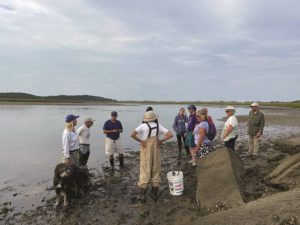
For biologists who have studied the Herring River for decades, like Barbara Brennessel, the story of that breakthrough period helps describe not only what is to come once the restoration project begins but how quickly the changes will occur.
While there is knowledge of the historical herring runs that are predicted to return post-restoration, until recently little work had been done to predict what might happen to the wild oyster set or how the project will affect the larger health of the oyster population.
So, three years ago, Brennessel teamed up with ecologist John Portnoy, who had spent over 30 years studying salt marshes at the Cape Cod National Seashore, and Jackie Fouse of the Friends of Herring River to create a baseline study of wild oyster spat.
Last week, Brennessel, Portnoy, and Fouse were joined by a group of local residents as they completed their last day of data collection in the river. The data, to be presented at the annual State of Wellfleet Harbor Conference in November, will help predict how renewed tidal flow will affect the wild oysters.
Brennessel’s team deployed quarry tiles in five locations in and around the Herring River: a control site at the Puffer grant on Mayo Beach, Pebbly Bar in the Herring River estuary, a site just seaward of the dike, a site just landward of the dike, and one further upriver, known as the Dog Leg. The tiles would serve as landing pads for the clouds of spat (oyster larvae) produced each summer in mid to late June, when higher temperatures trigger oysters to release millions of sperm and eggs.
Oyster farmers often keep quarry tiles, or similar substrate, on their grants to collect oyster spat, which are then chipped off the tiles and put into mesh bags to grow to maturity.
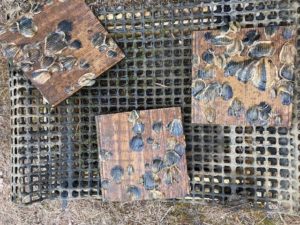
Over the past three years, the researchers found that little to no spat attached to tiles after the beginning of July. The larvae landed mostly during a short window in June. This is evidence of earlier spawning, likely due to increased temperatures in the harbor, Brennessel said. Over time, that could have implications for shellfishermen, who rely on spat collection to grow oysters.
Most telling was a small set of spat that was collected just inland of the dike, which Brennessel said is a good sign for oysters moving upstream during the restoration process.
“In our furthest site upriver, we didn’t find any oysters at all because that water is so fresh,” she said. “But we did find oysters just inland of the dike, and once we restore the tide, and the salt water can get through, there very well may be more acres of oysters than we currently see.”
The best spat set was found in the subtidal flats just seaward of the dike. Chopper Young used to harvest oysters there in the 1980s, before the area was closed because of high acidity and fecal coliform contamination from wildlife. “Thousands of bushels live, die, and never get to be touched up there,” Young said. “It’s virgin ground.”
Today, only 10 acres of the original 1,100 acres of salt marsh remain. Above the dike, the Herring River has been listed as “impaired” under the Clean Water Act.
With increased cycling of water once the new bridge is built, scientists predict a drastic improvement in the water quality. Construction of the bridge is set to start this fall.
“Clean salt water from the bay will bring in that desperately needed infusion of oxygen, dilute bacteria concentration, and shorten the lifespan of the bacteria,” said Portnoy.
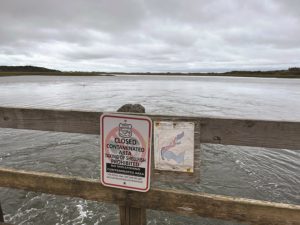
Experts predict an overall positive effect on the oysters in Wellfleet Harbor. Increased flow will allow them to filter more water and keep both the Herring River and the harbor clean, Brennessel said. It should also improve wild oyster productivity. “With more habitat for oysters to grow,” she said, “the entire oyster population that this industry relies on should really benefit.”
Aquaculturists in Wellfleet are cautiously optimistic about opening the dike. For them, the worry is whether there could be unforeseen consequences.
“Overall, we are pro-restoration because of the positive impact on the environment, town, and our industry,” said Zack Dixon, general manager of the Holbrook Oyster Company. “However, the project has been unwilling to establish any kind of fund or insurance for unforeseen consequences to our shellfish beds.”
One worry Dixon and others have raised is whether sediment transfer could cover their existing beds. But studies conducted over several decades by the Center for Coastal Studies and the National Seashore and hydrodynamic modeling of the river system conducted by the Woods Hole Group indicate that most sediment transportation will be upstream rather than toward oyster grants.
This upstream sediment deposition is part of what makes salt-marsh restoration projects important to long-term coastal resiliency. The upstream sedimentation allows the marsh to gain elevation, the better for facing down floods and sea-level rise.
Scientists have also found that channel velocities should work in the shellfishermen’s favor. They would be less than half the speed required to move sediment, except right at the dike — meaning any sediment movement toward the harbor would not spread far enough to reach the nearest shellfish grants.
Dixon says he and others don’t mistrust the science. “To be clear, I am actually pretty comfortable with this project and the science that has been done on sedimentation transfer,” he said. “It’s just that they’re unwilling to give us any type of assurances, except ‘We’ll stop if anything goes wrong.’ ”
That incremental approach is what project managers call “adaptive management.” Rather than opening the floodgates all at once, tidal flow will be restored in phases while scientists and managers monitor how the environment reacts to changes.
If there are unexpected system responses, said Herring River Restoration Project coordinator Carole Ridley, they should be detected early enough to make adjustments proactively.
ENVIRONMENT
Herring River Restoration Project Wins $29M Grant
Permitting steps remain, but construction could begin as soon as November
WELLFLEET — The Herring River Restoration Project is $29 million closer to beginning phase one.
On April 27, the Cape Cod Conservation District announced that the project would receive $29 million from the $42.5 million Cape Cod Water Resources Restoration Fund established for projects throughout the Cape under the Natural Resources Conservation Service (NRCS).
The Herring River, according to the Mass. Dept. of Ecological Restoration, “hosted one of the most important diadromous fish runs on Outer Cape Cod” until construction of the dike at the mouth of the river in 1909 shut off tidal flow. Now, the estuary is, according to the department’s website, “one of Cape Cod’s most degraded natural resources.”
Project coordinator and Harwich lawyer Carole Ridley said in a May 2 interview that the NRCS funding will cover “75 percent of the construction costs necessary for the Chequessett Neck Road bridge and one other project, still under review.”
Wellfleet is pursuing non-federal matching grants to fund the other 25 percent, according to Ridley.
Ridley said the project’s first phase aims to transform the three existing culverts at the Chequessett Neck Road dike, which allow up to 18 feet of tidal flow to pass through, to a 165-foot bridge with a tide gate system. This system would eventually rehabilitate 570 of the original salt marsh’s 1,100 acres, ecologist John Portnoy said during a May 7 guided tour of the dike. Portnoy said the project is the largest saltwater marsh restoration ever attempted in Massachusetts.
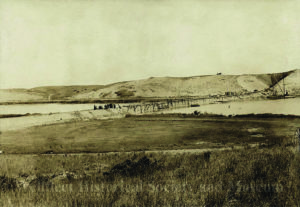
If the Wellfleet Conservation Commission approves the project’s orders of conditions at a meeting scheduled for May 18, bridge construction could begin as early as November, said Friends of Herring River board chair Dale Rheault.
As for costs, “$62 million is an estimate based on permit levels and design plans,” Ridley said. “It includes construction costs and monitoring adaptive management over the first five years of implementation. That number will be refined as design plans are finalized. That’s our best understanding of the cost today.”
In April, the project received a general permit from the U.S. Army Corps of Engineers and water quality certification from the Mass. Dept. of Environmental Protection, but the NRCS funding represents the project’s first significant allotment of money.
“The success of this project is based on a lengthy list of partners,” Barnstable County Commissioner Mark Forest said on April 28.
Interim Wellfleet Town Administrator Charlie Sumner told the Independent on May 2 that the town would be the “managing entity” for the NRCS funds. While the “lion’s share” of the money headed to Wellfleet is for the Herring River Restoration Project, Sumner said there are other recipients as well, namely drainage projects at two town landings and an erosion project at Keller’s corner.
Sumner hoped to finish the permitting process “relatively soon,” and while he remains optimistic the project will receive full funding, he acknowledged the town “needs to close the funding gap” before it can solicit bids.
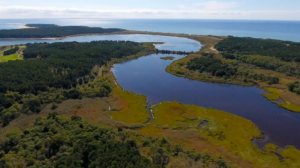
In light of Wellfleet’s current financial situation, Sumner said, “I have received a few emails and phone calls from citizens concerned about Wellfleet’s financial liability with this project. That’s a fair concern,” he added.
Though the project has aroused opposition from some residents, Friends of Herring River Executive Director Martha Craig described the mood at an April 14 conservation commission meeting as “100 percent positive.”
Barry McLaughlin, general manager of the Chequessett Golf Club, said at that meeting, “The club is enthusiastically behind this project, and we will do everything we can to be a very supportive partner.”
Because some of the club’s land would be damaged in phase one, Wellfleet agreed in February 2021 to provide the club with $6.7 million to rebuild parts of the course. Rheault is pleased about the golf partnership; on the May 7 tour, she said soil from the golf course could be used to build up low-lying roads.
Ridley explained that the Wetlands Protection Act requires that tidal restoration not “significantly affect the built environment.” Three private properties in addition to the golf course will be affected by phase one and will require mitigation, including elevation of some structures, Ridley said. All property owners are cooperating with the project, she added.
In an interview, Forest highlighted both local and broader potential benefits of restoring the salt marsh. “Restoring wetlands is important in tackling global climate change,” he said. “If we don’t have healthy wetlands, we’re in trouble.”
OPEN MEETING
The Flawed Governance of the Herring River Restoration
Announcing plans isn’t the same as involving the community in planning
An article in the April 22 Independent reminded us that the Herring River Restoration Project has progressed to the phase of seeking state and federal approval. The project’s nearly completed plan is expected to be implemented soon after the required permits are acquired.
It is not too late, however, to address a major deficiency in the project’s governance. The public officials on the project’s Executive Council are supported by technical experts from various state and federal agencies. Both groups are defined in the “Memorandum of Understanding IV Between the National Park Service and the Town of Wellfleet,” dated June 25, 2019.
MOU IV specifies that the Herring River Executive Council (HREC) is responsible for making all substantive decisions about the project. Its members are “the Wellfleet Town Administrator and two members of the Wellfleet Select Board, or alternatively, up to three designee(s) appointed by the Select Board; [and] The Superintendent of the Cape Cod National Seashore or his/her designee, and one additional CCNS designee.”
The Executive Council is thus made up of transients. Of the 12 people who have served on the council during its four-year life span, seven have come and gone. Only one member who attended the first meeting in 2017 remains on the council today.
Executive Council members are not required to have the education or experience necessary to make scientific or ecological judgments. The following provision in MOU IV compensates for the council’s acknowledged lack of scientific knowledge: “The HREC may seek technical guidance and assistance from the expert technical personnel of the Parties and Project Partner Agencies individually as members of the Herring River Technical Team.”
MOU IV defines the Technical Team as follows: “The HRTT shall have no set number of members, it meets as needed or desired, and may consist of staff members from … [a group of named] federal, state, and local governmental entities.… Participating staff members shall be designated at the sole discretion of any participating agency.”
Earlier in the Technical Team’s history — when it was called the Herring River Technical Committee — its deliberations were public. That changed when Wellfleet and the National Park Service revised their agreement in June 2019. MOU IV reads: “The Parties disclaim any intention to create in the HRTT a public body for purposes of the Massachusetts Open Meeting Law or the federal or Massachusetts Public Records Act.” Thereafter, the public has learned only what the decision-makers choose to disclose. Telling the public about what is planned and involving the community in the planning are not the same. Advisory committees directed by the decision-makers have been perfunctory and ineffective.
Not even the identity of the technical experts has been publicly reported since MOU IV became binding. The Technical Team has not provided any succession plan. Lack of transparency makes it unclear whether younger scientists have joined the group to ensure a scientific bridge to the project’s long-term future. The ecological transition of the estuary, which is expected to last for decades, will require well-informed management throughout. That duration will almost certainly extend beyond the current Technical Team members’ employment with the agencies they represent.
The severe constraints imposed by MOU IV on the governance of the Herring River Restoration Project threaten its success. As matters currently stand, the project will be implemented by an ever-changing group of elected and appointed officials who have insufficient scientific knowledge to make critical decisions. The project’s scientific agenda is determined by state and federal employees who are not appointed or controlled by local officials.
The public-facing decision-makers — the Executive Council — are theoretically accountable to the community. The Technical Team, however, is making the major decisions in the shadows without public oversight.
Now would be an excellent time for one or more Outer Cape residents who are knowledgeable about the design of successful organizations to volunteer their services to help rescue this project from the serious threat of a flawed governance structure. A fresh look is long overdue.
ENVIRONMENT
Golf Club to Get $6.7M for Herring River Project
The agreement includes two years of lost revenue
WELLFLEET — The town and the Chequessett Yacht & Country Club have reached an agreement that will allow the Herring River Restoration Project, the largest wetland restoration in New England, to go forward while also saving the club’s golf course.
On Feb. 9, the Wellfleet Select Board signed an agreement to give the club $6.7 million to elevate five low-lying tees, fairways, greens, roughs, and sand traps that would otherwise be flooded as the 570-acre first phase of the restoration project moves forward. The funds will also cover adjustments to upland holes 2 through 5, so that they coordinate with the newly elevated parts of the course.
The $6.7 million agreed to on Feb. 9 is 34 percent more than the $5 million “nonbinding placeholder figure” that had been offered to the club for years, said Carole Ridley, the restoration project’s coordinator.
Though the agreement is with the town as the legal entity, the restoration of the Herring River estuary is a multi-partner project involving several state and federal agencies, and all costs will be covered by federal, state, and private grants, said Ridley.
“It’s a big step,” said Anthony Papantonis of Wellfleet and Medfield, who is on the club’s board of governors and its Herring River committee.
It’s a step that almost didn’t happen. After many years of tense discussions, club members received a draft proposal from the Herring River technical team that they “were not happy with,” according to minutes from a Jan. 5 Wellfleet Select Board executive (that is, secret) session. The project staff and lawyers for the club had gone back and forth but could not come to an agreement.
On Jan. 5, Ridley told the select board the project would need to move forward to secure funding with or without a deal with the club. The restoration team hopes construction will begin in 2022, after 20 years of planning and negotiations.
According to the minutes of the January meeting, Helen Miranda Wilson told fellow select board members that the Herring River technical team had “bent over backwards for many years to look at all the details in good faith to make this happen with the club.” Wilson added that the club “is trying to pull the rug out at the last minute.”
The select board voted to give the country club until Jan. 29 to reach an agreement with the Herring River team, or else the town would move forward without one.
For the Chequessett club, which was incorporated in 1978 and has 200 members, no agreement would mean five of the nine holes that currently flood after rains would be permanently flooded when water levels rise in the restored Herring River — and none of the $60 million in state, federal, and grant funding for the project would go to fix it.
Ridley said the core understanding that has been in place remains the same, but the amount in the final agreement matches construction dollars for 2022.
Of the total, $5.7 million will go to construction costs, while $975,000 will be compensation for the loss of business. It’s assumed that construction will shut down the golf course for two years beginning in 2022, Papantonis said. Should construction begin later and go on longer, that amount will be adjusted, he added.
About $1.6 million in construction costs will be considered the club’s contribution, in the form of dirt or fill excavated from the golf club property. An estimated 180,000 cubic yards of fill are needed to raise the five holes, and another 70,000 cubic yards will elevate low-lying roads affected by the restoration.
Asked what had changed between January and February, Ridley said, “It’s a detailed agreement. What’s important is that there is an agreement that’s mutually beneficial.”
“It was like any negotiation,” Papantonis said. “We were able to come to certain resolutions, and we mutually decided to sign the agreement.”
Papantonis told the Independent that most of the members of the golf club are in favor of the Herring River restoration for environmental reasons. But, he added, “there are members, myself included, that are concerned about long- and short-term impacts to the club.”
Mike Snell, a Truro resident and active club member, said many of the members, like him, are elderly. “They are worried that if the club is closed for two years, membership will drop away,” Snell said.
For the Herring River Restoration Project, this is another milestone on a long journey. “The light at the end of the tunnel is getting brighter,” Ridley said.
Applications for state permits have gone out, and a final one to the U.S. Army Corps of Engineers will be sent in a week, Ridley said. The Wellfleet Conservation Commission will be the last permitting agency. After that, federal and state funding must be secured.
“The objective is to get all the funding and have it available,” Ridley said, adding that if funding cannot be found at once, the various partners in the project, including the town and the Cape Cod National Seashore, will have to discuss options.
HERRING RIVER
Fishing for Public Comment
The Friends of Herring River has a new survey for the public about the Herring River Restoration Project in Wellfleet and Truro. The survey is part of the project’s permitting process “and is intended to gain insight into public attitudes about various aspects of the project,” according to an announcement from the Friends. “Information gathered will help the project’s management team incorporate and understand community preferences in their decision-making process,” read the announcement.
The Friends, a nonprofit group, is working with Wellfleet, the Cape Cod National Seashore, and other state and federal groups to restore the tidal flow to the river. The survey can be accessed at herringriver.org, or people can participate in one of two virtual meetings to provide their input. The meetings will be held on Wednesday, Aug. 12 at 2 p.m. and Monday, Aug. 17 at 6:30 p.m.
For a paper copy of the survey, call Friends of Herring River at 508-214-0656. —K.C. Myers
RESTORATION
Support, and a Few Doubts, at Herring River Hearing
Long-planned Cape Cod Commission review is underway
WELLFLEET — Speakers lined up at microphones at the Council on Aging Monday to support the Herring River Project, which over 20 years could repair 570 acres of a salt marsh that was diked in 1909 for mosquito control and other purposes.
The project, the largest salt-marsh restoration in the state, has been discussed for decades and is now at the beginning of a two-year permitting process. But Monday night was a landmark moment — the first review of the project by the Cape Cod Commission (CCC) as a development of regional impact — and more than 100 people showed up.
“This is a river we have tried to kill for a hundred years,” said Gordon Peabody, an early proponent of the restoration. “We’ve forced it to breathe through a straw. It may only be a whisper at first, but it’s important to give it its voice back.”
At least a dozen representatives from various local, county, and statewide organizations spoke about the benefits expected from opening up the Chequessett Neck Road dike slowly to allow tidal water to flow in and out of the riverbed. The project will affect mostly Wellfleet and a small portion of Truro.
Those in support included state Rep. Sarah Peake, state Sen. Julian Cyr, the Chequessett Yacht & Country Club, the Wellfleet Historical Society & Museum, the Association for the Preservation of Cape Cod, the Wellfleet Open Space Committee, Wellfleet Conservation Commission, Massachusetts Audubon Society, and Supt. Gabrielle Sakolsky of the Cape Cod Mosquito Control Project.
Sakolsky said her agency has been involved in other salt marsh restorations and she is confident that they rarely lead to an increase in mosquitos. That is because the predator fish that feed on mosquito larvae will no longer be blocked from swimming up the river to eat the larvae, said Project Manager Carole Ridley.
The CCC staff wrote a 24-page report on the project. Its conclusion stated, “Probable project benefits … include water quality improvements, protecting and enhancing harvestable shellfish resources, enhancing opportunities for recreation and tourism, combating climate change through carbon storage in a restored salt marsh, invasive plant/Phragmites management, and re-establishing natural control of nuisance mosquitoes.”
Cape Cod marshes have been filled, diked, and restricted all over the peninsula. Mark Robinson, of the Compact for Cape Cod Conservation Trusts, said he found 16 tidal restrictions along Truro’s Pamet River, including dikes, culverts, and roadways, “collectively creating an incredibly impaired system,” Robinson said.
Rarely is there a chance to reverse the damage, said John Idman, the commission’s chief regulatory officer. That chance exists with the Herring River because 95 percent of the estuary is in the Cape Cod National Seashore, he added, though restoration must be balanced with care to prevent property damage. He said his staff felt “comforted” by the adaptive management strategies, which means the Seashore staff will open the tidal gates gradually and curtail the flow if there are unforeseen problems.
It was these unforeseen consequences that troubled several speakers Monday, including Paul Faxon of Chequessett Knolls Drive. His well is a few feet from the high-water mark in phase one of the restoration. (Phase one comprises 570 acres. Phase two would require further permitting.)
Faxon said he would like some conditions imposed on the project in case of unforeseen impacts to property owners, such as salt intrusion into his well.
Martin Nieski, of Old Chequessett Neck Road, listed various scenarios involving the rising river by his home, including making his property unusable because it will be designated as a wetland. Ridley said none of those scenarios would happen in phase one.
Dr. Ronald Gabel said the 2005 Sesuit Creek restoration in Dennis resulted in ugly swaths of eroded mudflats without new growth of saltwater plants.
Stephen Spear, a neighbor of Sesuit Creek and a member of the Herring River Technical Committee, said other areas of the creek have recolonized with saltwater species. But he admitted the Sesuit project did not all work as planned. “We’ve learned a lot since 2005,” he said.
The next review by the CCC is on Thursday, April 2, at 4:30 p.m. in the East Wing Conference Room of the Barnstable County Complex, in the old jailhouse.
LETTERS TO THE EDITOR
Letters, March 12, 2020
From Butch Mullaney and Barbara Brennessel
Pot Profits Should Stay Here
To the editor:
After reading about Provincetown’s financial woes it dawned on me: why couldn’t this town and others run the marijuana distribution business instead of outsourcing it to Curaleaf and all of the other shell companies that the Russian oligarchs have set up in North America?
How much of the billions of dollars goes to Putin? How much of it goes into interfering with our elections? Between the monetary windfall and Putin’s secret meetings with the Orange Cheeto in the White House, it makes me wonder: what else can we do to make the U.S.S.R. great again?
Our budget deficit has nearly doubled and our trade deficit has exceeded expectations under the Trump administration’s reign of terror on our democracy. I won’t go on ad nauseam about Putin’s puppet.
We need to put a stop to enemy countries coming here, taking out our money, and then using it against us. We must stop them from doing big business in the pot distribution and other drug opportunities that come down the road.
These lucrative businesses and others should be run by local and state authorities, and the money put to use in education, help for the poor, public housing (a desperate need), etc. A little eminent domain, please!
I, for one, will not be using Curaleaf or any of the other Russian-owned businesses. We need to get out of the quagmire our country is in right now.
Butch Mullaney
Provincetown
Herring River Terrapins
To the editor:
Wellfleet’s Herring River estuary is the northernmost range for the northern diamondback terrapin (Malaclemys terrapin terrapin) in the United States. This salt marsh turtle is listed as “threatened” in Massachusetts by the Natural Heritage and Endangered Species Program. The Herring River is an important nesting, foraging, and nursery habitat for terrapins. I have monitored the habitat utilization of diamondback terrapins in the Herring River estuary for the past nine years.
My monitoring shows that the Chequessett Neck Road dike is a major impediment to the movement of terrapins in the estuary. The dike prevents terrapins from reaching potential nesting, foraging, and nursery habitats. In addition, as terrapins climb up to the road in attempts to reach the landward side of the dike, they are sometimes killed by autos.
Based on my observations and monitoring data, I predict that restoration of tidal flow to the Herring River estuary and other aspects of the restoration will be a benefit to the species. This proposed project also aligns with the goals of the Regional Conservation Plan developed by the Diamondback Terrapin Working Group, which calls for habitat restoration throughout the terrapin’s range.
There are many reasons to support the Herring River Restoration Project. Protection of threatened populations of wildlife is yet another important goal for the project.
Barbara Brennessel
Wellfleet
The writer is a board member of Friends of Herring River.
LETTERS TO THE EDITOR
Letters, March 5, 2020
From Susan Baumgarten, John T. and Judith Kwiat Cumbler, Paul Mendes, and Jane Peters
An Experiment on the River
To the editor:
Your front-page article “How Restored River Will Alter Wellfleet Views” (Feb. 27) leaves unanswered many questions about the Herring River Restoration Project. The word “will” should have been replaced with “may”:
It may not work. Science is characterized by predictability and replicability. The restoration is an experiment that has neither hallmark and may do more harm than good. While the flooding may create a saltwater marsh, it will not be the same one that existed before the dike was built. And as happened in the Sesuit Creek restoration in Dennis, unexpectedly slow or nonexistent regrowth of saltwater grasses may result in an ugly, smelly landscape.
It may harm Wellfleet’s oyster beds. The experimental model does not guarantee that Wellfleet’s oyster beds will be unscathed by sediment flowing downstream from the estuary, and adaptive management is an unproven tool for preventing this damage. The project must provide insurance or other funding to directly and promptly compensate shellfishermen for damage to their beds. It is unfair to shift the risk to people who will be seriously harmed if their livelihood is interrupted.
It may put the Chequessett Yacht & Country Club out of business. Wellfleet reaps substantial economic and social benefit from the club. It will take time and money to rebuild the membership after a two-year closure, and the club may not survive at all as members shift their loyalty to other clubs.
It may create huge liability for the town of Wellfleet. Truro wisely withdrew from the restoration. Wellfleet’s taxpayers could be liable for damages to the shellfishermen and private home owners. This burden will fall most harshly on those in Wellfleet who struggle to pay their bills.
Until the project proponents address these unresolved issues, they should not receive permits to flood the Herring River estuary.
Susan Baumgarten
Wellfleet
To Reverse a Decline
To the editor:
The Herring River is in an advanced state of decline. Acidification is increasing, the marsh is sinking, and the drainage from a degraded marsh is compromising shellfish beds. The restoration of the river will dramatically reduce these negative impacts on the ecosystem.
The restoration will also limit the stress on herring of dealing with highly acidic and polluted water, as well as opening up more space for the herring to run, thus reducing predation particularly in narrow culverts. The flushing of the river will support greater diversity of marine life, expand the nursery for juvenile fish, and perhaps even provide a spawning area for striped bass. Sand eels, a significant food source for striped bass and bluefish, will most likely recolonize the mouth of the river. With the increase in these fish will come fishermen who will add to the local economy.
Although we enjoy our regular walks along Snake Creek and High Toss roads, it always saddens us to realize that this wetland would be a healthy salt marsh if not for the dike at the mouth of the river. We have kayaked the Herring River for years, but with the opening up of the dike the kayaking will vastly improve. The expanding salt marsh will be an important buffer to storms, which are predicted to be significantly more severe with climate change. The restored marsh will also be an important sink for carbon, thus contributing to mitigating the burning of fossil fuels.
This project is long overdue. It will benefit the town, the Cape, the Commonwealth, and the environment. It has our absolute support.
John T. Cumbler
Judith Kwiat Cumbler
Wellfleet
Why a Medal Matters
To the editor:
The article on Harold Hall’s long wait for his Purple Heart (Feb. 27, page 5) is symbolic of what happens to many men and women who serve our country only to return and have their contributions go unrecognized. That is why a citation matters so much. They are a necessary point of pride, recognized both by active service members and civilians.
I, for one, want to thank all those who are endeavoring to have Mr. Hall receive his long overdue Purple Heart medal and, if he wants it, the license plate. They will help make his sacrifice visible to all.
Paul Mendes
Provincetown
The writer served with the U.S. Marines in Vietnam.
Crank Letter
To the editor:
Thank you for the articles about the recent Truro special election. One of the hats I wear is that I am the “Town Crank” who operates the old-fashioned yet perfectly usable ballot machine. Your editorial about the old box was perfect.
Jane Peters
Truro
How Restored River Will Alter Wellfleet Views
A tour of five places that Herring River project will change
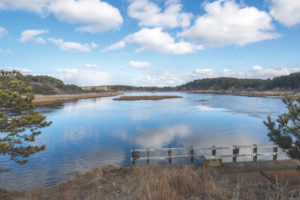
WELLFLEET — After two decades of planning, the official review of the massive Herring River Restoration Project will begin on March 9 when the Cape Cod Commission considers the first permits for phase one of the work. This meeting, starting at 5 p.m. at the Wellfleet Council on Aging, is the first of what’s predicted to be two years of hearings before the first shovel hits the mudflats.
